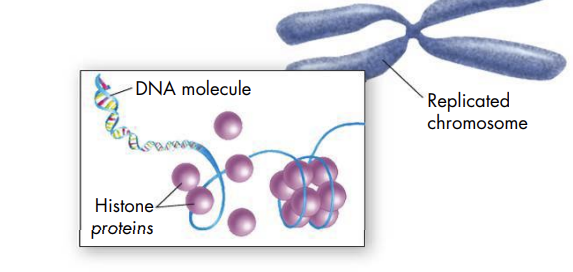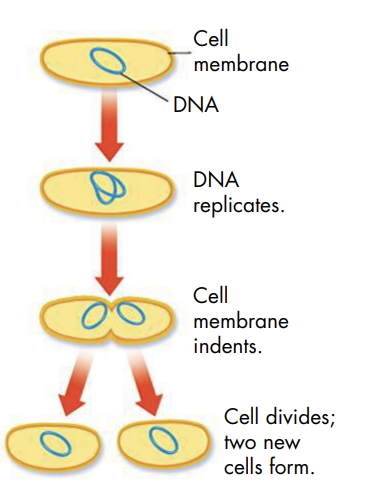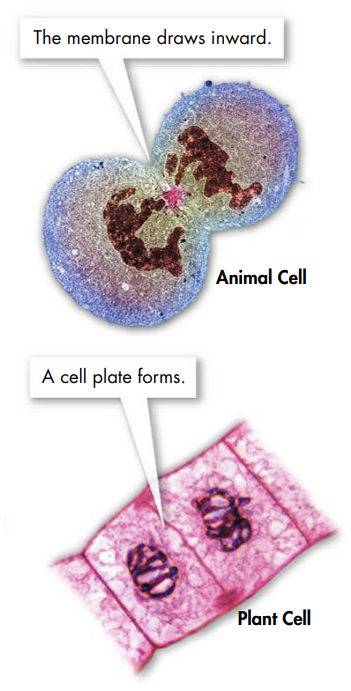Chapter 10: Cell Growth and Division
10.1 Cell Growth, Division, and Reproduction
Limits to Cell Size
There are two main reasons why cells divide instead of continuing to grow
First, the larger a cell becomes, the more demands the cell has on its DNA
Second, a large cell has more trouble moving enough food in and enough waste out
As a cell grows, the size of its cell membrane does not grow as fast as its volume
Cell Division and Reproduction
Before it becomes too large, a growing cell divides into two new cells that are referred to as “daughter” cells; this process is called cell division
During the process of cell division, a cell makes a copy of its DNA, with each daughter cell getting its own copy; this copying solves the problem of information overload
Cell division also decreases a cell’s volume, which allows for a better exchange of materials in and out of the cell
Cell division can also result in reproduction - the process by which organisms produce offspring (new organisms)
Asexual reproduction is a process by which a single parent reproduces by itself, with offspring of asexual reproduction having the same genetic information as their parent
For example, hydras reproduce asexually by budding
As cells divide, the bud grows and eventually separates from the parent
The main advantages of asexual reproduction are that it is quick and that it produces genetically identical offspring
The lack of genetic diversity can be a disadvantage of asexual reproduction, since asexually reproducing organisms may not have needed characteristics if their environment changes rapidly
Sexual reproduction is a process by which two cells from different parents fuse, or join together, to produce the first cell of a new organism, with offspring having genetic information from both parents
The main advantage of sexual reproduction is that offspring are genetically different from their parents, letting species “try out” new combinations of genetic information from one generation to the next; if the environment changes rapidly, some members of a species may be able to adjust to those changes
A disadvantage of sexual reproduction is that it is generally slower than asexual reproduction since it takes two parents instead of one to produce offspring
10.2 The Process of Cell Division
Chromosomes
Cells package each molecule of DNA into a structure called a chromosome - a threadlike structure that contains the genetic information that is passed from one generation of cells to the next
Chromosomes make it possible to separate DNA precisely during cell division
Prokaryotic cells do not have a nucleus; instead, the DNA molecules of prokaryotic cells are found in the cytoplasm.
Usually, the genetic material is contained in a single, circle-shaped chromosome
The DNA molecules of eukaryotic cells are found in the cell nucleus
Eukaryotic cells have much more DNA than prokaryotes that they package into many chromosomes
The chromosomes in eukaryotic cells form a close relationship with special proteins called histones, which help to keep long molecules of DNA organized in eukaryotic cells
Chromatin is a substance found in eukaryotic chromosomes that consists of DNA tightly coiled around histones
As a cell gets ready to divide, chromatin condenses, and individual chromosomes become visible inside the cell

The Cell Cycle
The cell cycle is a series of events a cell goes through as it grows and divides
During the cell cycle, a cell grows, prepares for division by making a copy of its DNA, and then divides to form two daughter cells, each of which then begins the cycle again
Before any cell divides, it must copy, or replicate, its DNA by synthesizing new strands of DNA so that each cell receives a complete set of genetic information
The prokaryotic cell cycle includes cell growth, DNA replication, and cell division
The process of cell division in prokaryotes is a form of asexual reproduction called binary fission - a process that produces two genetically identical organisms

The Eukaryotic cell cycle has four phases: G1, S, G2, and M; the period of growth between cell divisions is referred to as interphase and includes G1, S, and G2 (eukaryotic cells spend most of their time in interphase)
A cell does most of its growing during the G1 phase, increasing in size and producing new proteins and organelles
Though the G in G1 and G2 stands for “gap,” both G phases are periods of growth and activity
During the S phase, new DNA is synthesized when chromosomes are replicated
The S stands for “synthesis”
In the G2 phase, a cell prepares for cell division by producing many of the needed organelles and molecules
At the end of the G2 phase, a cell is ready to begin the process of cell division
The M phase is a series of events that lead to the division of the cell nucleus
The “M” in the M phase stands for mitosis, the first stage during which the nucleus divides
Cytokinesis is the second stage during which the cytoplasm divides
At the end of the M phase, two new daughter cells begin the cycle again
Mitosis
Mitosis is divided into four phases: prophase, metaphase, anaphase, and telophase
Prophase is the first phase of mitosis
The replicated chromosomes become visible as DNA starts to condense
Each strand of DNA in a doubled chromosome is called a chromatid; sister chromatids are joined at an area called the centromere
The nuclear envelope breaks down, and a spindle begins to form; a pair of structures called centrioles help to organize the spindle fibers
Metaphase is the second phase of mitosis
The chromosomes line up at the center of the cell, and spindle fibers connect the centromere of each chromosome to the spindle
Anaphase is the third phase of mitosis
The centromeres split, and the sister chromatids separate
A complete set of chromosomes move to opposite sides of the cell
Telophase is the fourth and final phase of mitosis
The chromosomes spread out into a tangle of chromatin, a nuclear envelope reforms around each group of chromosomes, and the spindle begins to break apart
At this point, mitosis is complete, but cell division still has one more step to go
Cytokinesis
Cytokinesis completes cell division by splitting one cell into two daughter cells; this process differs between animal and plant cells
In animal cells, the cell membrane pinches in
In plant cells, a cell plate forms

10.3 Regulating the Cell Cycle
Controls on Cell Division
In multicellular organisms, the cell cycle is carefully controlled; in your body, for example, skin cells grow and divide quickly, though most of the cells in your muscles and nerves do not grow and divide
The cell cycle is controlled by regulatory proteins both inside and outside the cell
Proteins that respond to events outside the cell are called external regulators, and they can cause the cell cycle to speed up or slow down
Growth factor is an external regulatory protein that stimulates the growth and division of cells
Proteins that respond to events inside the cell are called internal regulators, and they control the stages of the cell cycle
Cyclins are a group of regulatory proteins that regulate the timing of the cell cycle in eukaryotic cells
Some cells die by accident because of damage or injury, while other cells, such as skin cells, are “programmed” to die
The process that brings an end to the cell cycle is called apoptosis
Cancer: Uncontrolled Cell Growth
Cancer is a disorder in which some of the body’s own cells lose the ability to control growth
Cancer cells do not respond to the signals that regulate the growth of most cells; as a result, cells divide uncontrollably
Cancer cells form into a mass of cells called a tumor
Not all tumors are cancerous
Cancer treatments can include surgery, radiation treatment, and chemotherapy
10.4 Cell Differentiation
From One Cell to Many
During the development of an organism, cells differentiate into many types of cells
An embryo is an organism in its early stage of development
During the development process, the embryo’s cells become different from one another
Differentiation is a process in which cells become specialized in structure and function
A differentiated cell has become different from the original cell that produced it
Differentiated cells are specialized to perform certain jobs
Ex: In a plant, some cells carry out photosynthesis, some plant cells store sugars, and other plant cells create pathways for moving materials up and down
Stem Cells and Development
The fertilized egg and the cells produced by the first few divisions are totipotent - meaning they have the ability to develop into all the tissues of the body
Early in development, a human embryo forms into a blastocyst - a hollow ball of cells with a group of cells inside called the inner cell mass
The outer cells form tissues that attach the embryo to its mother
The inner cell mass becomes the embryo itself
The cells of the inner cell mass are pluripotent - meaning they are able to develop into all the body’s cell types, but not capable of developing into the tissues surrounding the embryo
Differentiated, specialized cells develop from unspecialized cells known as stem cells
Embryonic stem cells are the cells that make up the inner cell mass of a blastocyst and can develop into different kinds of body cells
Adult stem cells are multipotent - meaning, they have the ability to produce many, but not all, kinds of differentiated cells
For example, adult stem cells in the bone marrow can develop into several types of blood cells
Stem cells offer the possible benefit of using undifferentiated cells to repair or replace badly damaged cells and tissues; however, human embryonic stem cell research is controversial because it involves issues of life and death
 Knowt
Knowt
